Downloads
Thank you for the invitation to speak at this annual event. It is a particular pleasure to be here with my colleague Asakawa-san.
Today I shall focus my remarks on international economic developments and discuss some of the key policy debates within the International Monetary Fund (IMF) and the G20.
Japan and Australia each have an interest in strong and stable growth in the global economy. We work cooperatively on achieving this through a range of international forums and institutions.
As I mentioned in my remarks at CEDA earlier this month, the global economy is in the midst of a major transformation. Two big forces — increasing global connectivity and a shift in the economic balance of power — warrant particular attention.
Increased global connectivity, while largely positive for growth, has changed the nature of global risk. In particular greater financial interconnectedness has brought with it rapid and potentially more volatile capital flows.
Owing to this increased connectivity, an effective and credible global financial safety net, with the IMF at its heart, is increasingly important. But there are questions about the adequacy of financial resources and coherence of the global financial safety net, prompted in part by the centre of global economic gravity shifting towards Asia.
For all nations, establishing strong economic frameworks and policies is the first and most important line of defence against economic malaise. For this reason, the IMF’s surveillance function is critical. At the recent G-20 Finance Ministers and Central Bank Governors Meeting in Shanghai, ministers and governors warmly welcomed Argentina’s commitment to reengage in Fund surveillance.
First, I should like to outline in broad terms our outlook for global growth to provide a frame to the current policy discussions. For Australia, the broad context is that the economy has performed remarkably well over the past couple of decades in the face of extremely large global shocks.
Global Economic Outlook
Level of real GDP in major advanced economies
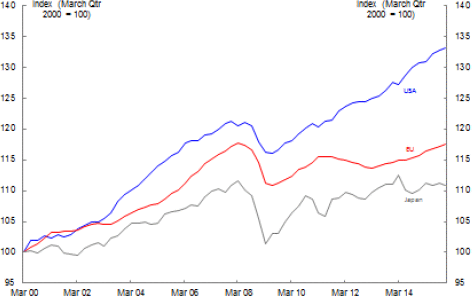
Source: Bloomberg
Amongst the major advanced economies, the United States is the bright spot. But you can see from the chart that it is still on a lower path than during the decade before the financial crisis. The Eurozone and Japan are both still struggling to return to pre-crisis levels of real GDP. While Japan’s performance is stronger on a per capita basis, for global output, and for its trading partners, it is the aggregate level that matters.
Oil prices have declined markedly since September 2015, largely because of supply side factors. Usually, a decline in oil prices driven by higher supply would be expected to support global aggregate demand, because of the higher propensity to spend in oil importers.
But, so far, low oil prices are proving less stimulatory than anticipated, partly because of the strains imposed on oil exporters and partly because of reduced investment in extraction. In addition, consumption growth in oil importers has been weaker than in past price cycles, possibly because of de-leveraging.
There are several implications from the fact that global growth remains fragile and returning to pre-crisis rates of growth is proving difficult. Advanced economies bear the scars of having had insufficient growth for too long.
Slower than expected growth is heightening risks globally, with financial market volatility increasing as investors reassess valuations in light of slipping global growth prospects.
Against a somewhat grim assessment by the IMF, G20 Finance Ministers and Central Bank Governors noted at their February meeting that economic fundamentals remain sound in many major economies. They cautioned that at least some of the recent market volatility may not have been driven by a change in the underlying fundamentals.
We expect that the US will continue to support global demand, thanks in part to its strengthening labour market. We can expect a gradual tightening in US monetary policy as the US economy strengthens.
In Japan and Europe, given demographic and deflationary challenges, growth prospects have been revised down to relatively low levels. In order to help remedy this, Central Banks in several economies have introduced a negative interest rate policy.
There are limits to what monetary policy alone can achieve. The IMF is arguing for more active and coordinated fiscal policy. But further use of fiscal policy is complicated by high levels of public debt. There is room for countries to look to direct spending on the most growth friendly areas while maintaining a discipline around spending envelopes. It is important for countries to keep their fiscal policy well-anchored, which will require focussed effort.
Given the weakness in advanced economies, emerging market and developing economies have been the main source of global growth. Since 2000, this group has accounted for, on average, around 75 per cent of total global growth. But EMEs are struggling to maintain their momentum and EME growth rates have roughly halved from 7.5 per cent in 2010 to just 4 per cent in 2015.
The slow-down in China is of particular significance for Australia and our region.
China’s growth has been slowing as its economic transition from investment to consumption and services-led growth occurs. This transition is necessary and its growth impacts are expected. The Chinese economy grew by 6.9 per cent in 2015 – the lowest rate since 1990 – and is likely to continue to slow as Chinese authorities rebalance the economy away from investment-led growth towards more consumption and the services sector, and as the working age population declines.
The challenge for Chinese policy makers will be managing the tension between pursuing reforms to rebalance the economy and policies that support short-term growth.
At the National People’s Congress in early March 2016, Premier Li Keqiang announced that the government would lower its 2016 growth target to a range of 6.5 – 7 per cent, compared to “around 7.0 per cent” in 2015.
While consumption growth has been solid – it has grown faster than GDP since 2011 – it will not fully offset the decline in investment and more moderate growth will be the ‘new normal’ going forward.
The recent cut to the Reserve Requirement Ratio and China’s expansionary fiscal stance is consistent with the view that authorities are looking to support short-term growth.
But there remain risks to longer term GDP growth, including excess capacity in heavy industries and oversupply in the property market, as well as high and rising levels of debt.
Other major EMEs are struggling with the effects of low commodity prices and, in some cases, geopolitical and governance issues. Both Russia and Brazil are expected to contract in 2015 and 2016. On a more positive note, India – a major commodity importer – is now the fastest growing major economy, with growth expected to reach 7.5 per cent in 2016.
But overall global growth remains fragile and the risks are tilted to the downside.
Global Risks and capital flows
The risks to growth are shifting from advanced economies to emerging economies.
The IMF and the Financial Stability Board (FSB) are concerned about the risks of financial spill-overs from emerging market economies — and are focussing on international capital flows given the main role they play in transmitting risk.
While EMEs have typically been net capital inflow recipients, last year was characterised by net capital outflows from EMEs, led by China.
Variability in Capital Flows
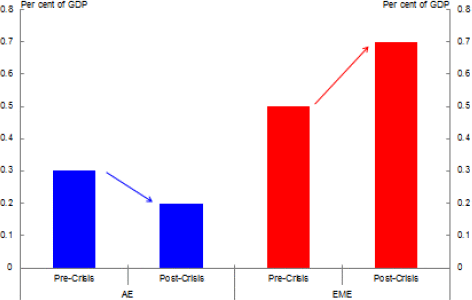
Source: IMF
Note: Standard deviation of net capital flows vis-a-vis trend
This is consistent with increased volatility of capital flows to EMEs since the financial crisis. The fact that the volatility of net capital flows to EMEs has increased despite the fall in the volume of gross capital flows globally since the financial crisis is noteworthy.
A key question for us to consider is to gain a better understanding of what is causing this volatility and sudden rush of capital flows into and out of EMEs.
Non-financial corporate debt
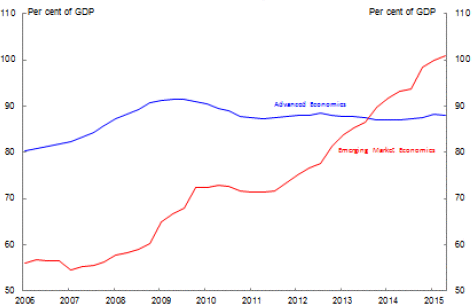
Source: Bank for International Settlements
To a large extent, this has been driven by advanced economy investors in their global search-for-yield given very low interest rates at home. For the 12 largest emerging markets, this has led to non-financial corporate debt rising from around 60 per cent of their collective GDP in 2008, to more than 100 per cent in 2015.
In fact, US dollar denominated debt has been growing faster in EMEs than in the United States itself. The Economist estimated that in 2015, US dollar denominated debt was more than 10 per cent of GDP in Brazil and nearly 20 per cent in Indonesia, Russia and Turkey.
The prospect of further US interest rate rises and the appreciation of the US dollar is creating more pressure for EMEs by increasing the costs of servicing US dollar denominated debt.
But to what extent do these volatile capital flows to EMEs constitute a global risk?
The IMF’s chief concern is over non-financial corporates and commodity exporters, because the collapse of commodity prices - and therefore corporate earnings - has increased financial stress in EMEs.
Weak governance is also to blame in more than one example of an EME commodity exporter experiencing financial distress. Probably the most familiar to this audience is Petrobras, Brazil’s oil giant.
Of course, many EMEs believe that their fundamentals are sound and that it is the volatility of capital flows which is negatively affecting their economies. While some of these concerns may be valid, having an economy which welcomes and utilises capital flows efficiently is beneficial for growth and development in the long term.
The debate is particularly intense over the appropriate rate of liberalisation of China’s capital account.
China estimated captial flow
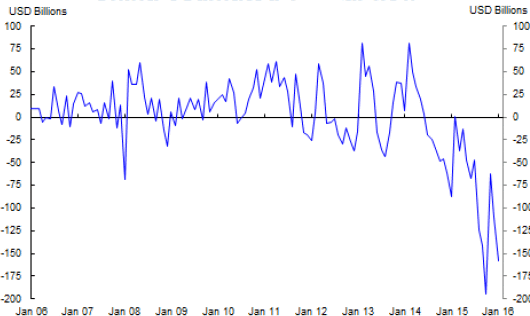
Source: Bloomberg
China cross-border claims fall
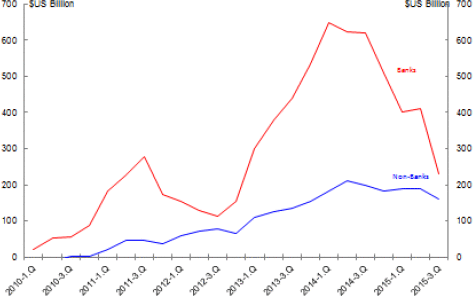
Source: Bank for International Settlements
Capital outflows from China are estimated to have reached US$1 trillion in 2015, compared to outflows of US$134 billion in 2014. But to date this has largely reflected Chinese corporates reducing foreign currency borrowing rather than ‘capital flight’ per se.
Moves in the last couple of months to tighten capital controls and curb capital outflows signal that capital account liberalisation is being balanced with the desire to stabilise the Chinese currency.
A useful reference is Japan’s capital account liberalisation, which was also a gradual process: one that allowed domestic financial markets to mature as they integrated internationally. Australia’s opening was similarly gradual, though it accelerated rapidly towards the end.
In this context, the IMF has highlighted the importance of sequencing domestic financial market deepening and international financial integration. Sudden capital account liberalisation, especially when markets are still immature, can invite destabilising capital flows.
While it took some time for Australian private and public institutions to learn how to manage risk in an environment with an open capital account and a flexible exchange rate, these institutional and market settings now allow us to benefit more from foreign capital flows.
The flexible exchange rate has been a major factor in the Australian economy’s resilience over the past couple of decades.
While net capital inflows to Australia have recently been around half of that of the decade before the financial crisis (it was as high as 7 per cent of GDP), Australia’s domestic policy settings meant our economy was able to absorb a once-in-a-century terms of trade shock.
Foreign currency exposure, by sector
Per cent of GDP, as at March 2013
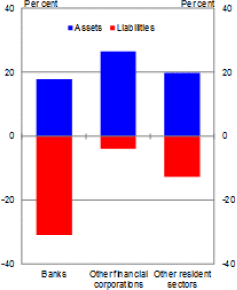
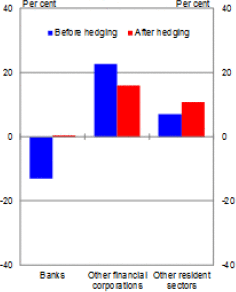
Source: ABS Catalogue Number 5308.0.
Indeed, the depreciation of the Australian dollar relative to its highs during the mining boom encourages capital inflows to return, facilitates both domestic and foreign investment in the non-mining sector and supports wages and employment growth. Our mature financial markets also mean that most Australian private and public debt is denominated in Australian dollars – and much of the stock of foreign denominated debt is hedged, particularly in the banking sector.
Australia stopped using capital controls when we floated the dollar in December 1983.
It may not yet be appropriate for all countries to adopt similarly liberal settings.
In the face of heightened capital flight risk, it may be appropriate for some EMEs to use capital flow management measures as a short-term solution. Care needs to be taken in using such measures. In general, they are a poor substitute for domestic reforms. There are risks that such measures can prove counter-productive, especially if maintained for longer than needed.
The G20 and the IMF are working together to consider if there is a need to revisit the IMF’s 2011 Institutional View on Management of Capital Flows. Australia is open to mature discussion on the merits of this.
Through the Data Gaps Initiative, the G20 is also improving the monitoring of capital flows and global liquidity to help improve the early detection of potential financial crisis.
Dealing with crises
But what if another global financial crisis occurs? Is the global financial safety net adequately resourced and do its various components coordinate effectively?
Coordination is now particularly important as the IMF is no longer the only game in town when it comes to fighting financial crises. It has been joined by Regional Financial Arrangements, such as the European Stability Mechanism (ESM) and, in our region, by the Chiang Mai Initiative Multilateralisation (CMIM).
In addition, a network of bilateral swap arrangements - typically between central banks - has been developed between a number of countries; and the GFC experience shows that swap arrangements can be expanded very quickly when needed.
Lastly, most countries also seek self-insurance through acquiring a stock of official foreign reserves. Australia holds relatively modest reserves in comparison to other countries (currently around A$60 billion).
On the IMF however, the good news is that earlier this year the 14th Review of Quota and Governance was passed, after having been held up by gridlock in the US Congress since 2010. We are pleased that IMF members were willing to continue to invest in the Fund, seeing the valuable
role it plays in supporting the stability of the global economy.
This reform has effectively doubled the permanent ‘on-call’ resources of the Fund, called IMF Quota, to be around US$665 billion.
At the same time, a borrowing arrangement of up to SDR 370 billion (or about US$520 billion) between the IMF and a set of 38 advanced and emerging economies (including Australia) has been reduced. We do not expect it to play a major role in funding future programs.
IMF Resources and Lending
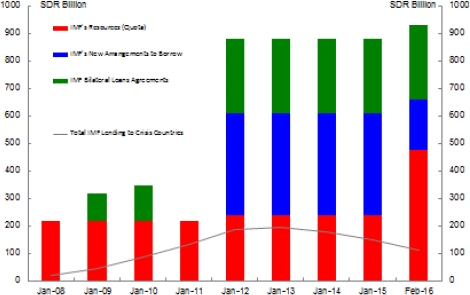
Source: IMF Finance Department
But is the IMF well resourced? This is harder to say. So far the IMF has had enough resources to meet its lending programs, many of which have focused on Europe in recent years. But the IMF had to rely on borrowed funds from its members to meet this demand.
Recent IMF reforms will help by increasing resources. Additionally, they will diversify funding sources away from the 38 countries which agreed to loan the IMF resources to the IMF’s 188 members.
More importantly, this has boosted the credibility of the IMF. A more representative Fund is better able to undertake surveillance and facilitate more even-handed treatment of its members.
It bears emphasising that effective surveillance, which is ‘owned’ by the Fund’s membership and in particular the systemically important economies, is the often forgotten keystone of any workable global safety net. No amount of external financing can make up for the absence of robust domestic policy frameworks.
In this context, the Fund’s credibility is fundamentally linked with EMEs becoming more visibly represented at the Board, as well as their voting weights increasing, to reflect their growing weight in the global economy.
China GDP Share versus IMF Quota Share
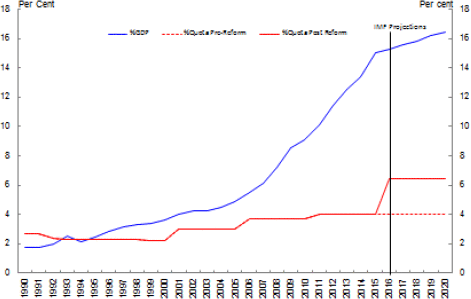
Source: IMF October 2015 WEO
In the case of China, this has meant that its quota share – and hence voting power – will increase from 4 per cent to around 6.4 per cent.
The shift in the centre of economic gravity towards Asia is reflected not just within the IMF but also beyond it with the development of new institutions, such as the BRICS Contingent Reserve Arrangement (US$100 billion) and the Chiang Mai Initiative Multilateralisation (CMIM) in Asia – which is a commitment to pool up to US$240 billion of members’ foreign exchange reserves.
Multilateral Development Banks, such as the World Bank and the Asian Development Bank, can also play a role by quickly mobilising short-term financing to developing countries. It is conceivable that the newly-established Asian Infrastructure Investment Bank (US$100 billion) might also take on a similar role in a future crisis.
Europe has also established its own Regional Financial Arrangement, the European Stability Mechanism (ESM) with a maximum lending capacity of €700 billion – which is in the same league as the IMF itself.
The IMF, the Regional Financial Arrangements and the Bilateral Swaps will be most effective where they coordinate with each other. Currently, the IMF and the ESM continue to have differing views on the Greek rescue package. The IMF has, at least for now, stepped back from a financing role after Greece fell into arrears on its IMF repayments – and has been replaced by the ESM.
While an argument could be made that ESM is in fact supplementing the IMF’s resources, the public disagreement between the IMF and the ESM over Greece’s debt sustainability suggests that coordination between the global and regional levels is rather less than might be hoped.
Bilateral Swap Arrangements, by virtue of being swift and credible can be very effective in fighting (or preventing) a financial crisis.
For example, the swap agreement used to provide access to short-term funds from the United States (for up to US$ 30 billion) and Japan (for up to US$20 billion) to the Republic of Korea during the Global Financial Crisis was crucial in helping to prevent a crisis in Korea.
The resources available through these swaps are considerable. One US think-tank suggests that Bilateral Swaps are roughly equivalent in size to the IMF.
But these swaps are not in place for all potentially needy countries, but rather are offered by systemic countries to a select few.
There is also the question about the extent to which foreign exchange reserves should be built up as self-insurance against a crisis. Especially since the Asian Financial Crisis, there has been a preference for more rather than less, and foreign reserves have increased steeply from US$1.5 trillion in 1995 to more than US$11 trillion today.
If the safety net is simply the aggregation of these pools of money, this would make official foreign reserves its most important component.
But US$11 trillion may well be costly over-insurance, or worse, potentially unusable in a crisis. This is because sharply running down these reserves could attract unwanted attention.
In addition, confronting the low yield environment prevalent in safe assets in recent years, many sovereigns have opted to invest significant portions of their reserves in illiquid assets. And it is worth noting that none of the nine largest emerging market economies touched their reserves during the global financial crisis.
Balancing the global and regional levels of international architecture, not only for crisis fighting but more broadly, is one of the key questions to be addressed in the next few years. Australia has traditionally preferred solutions to be pursued at the global level, as this is most likely to result in consistent and coherent treatment.
The relationship between the IMF and the Regional Financial Arrangements, and the adequacy of the broader Global Financial Safety Net’s resources is being discussed by the G20 this year. We look forward to supporting this work as effective international institutions remain a core economic and strategic interest for Australia.
Conclusion
In conclusion, the international economic outlook remains challenging.
Greater financial interconnectedness has brought with it more rapid capital flows, which potentially increase financial stress, particularly in EMEs.
The IMF is at the heart of the global financial safety net which is designed to help prevent, and improve the response to, financial crises. Despite the recent reforms, work remains to be done on revisiting what role the IMF should play into the future, its size and relationship with other elements of the global financial safety net. Underpinning its credibility through ongoing evolution of its governance and representativeness will remain important.
All that said, I want to stress that the first and best way to mitigate global or regional crises in the future and to achieve strong, sustainable and balanced growth is to focus on our domestic policies and settings.
Thank you